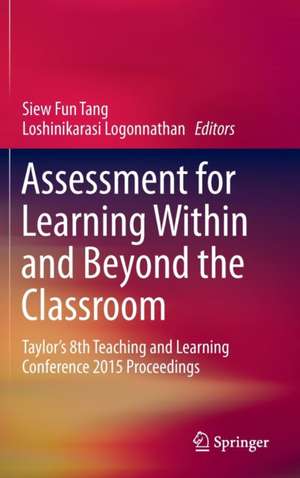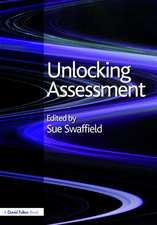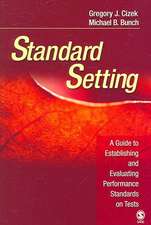Assessment for Learning Within and Beyond the Classroom: Taylor’s 8th Teaching and Learning Conference 2015 Proceedings
Editat de Siew Fun Tang, Loshinikarasi Logonnathanen Limba Engleză Hardback – 29 iun 2016
| Toate formatele și edițiile | Preț | Express |
|---|---|---|
| Paperback (1) | 952.09 lei 6-8 săpt. | |
| Springer Nature Singapore – 30 mai 2018 | 952.09 lei 6-8 săpt. | |
| Hardback (1) | 958.25 lei 6-8 săpt. | |
| Springer Nature Singapore – 29 iun 2016 | 958.25 lei 6-8 săpt. |
Preț: 958.25 lei
Preț vechi: 1168.60 lei
-18% Nou
Puncte Express: 1437
Preț estimativ în valută:
183.39€ • 189.45$ • 152.62£
183.39€ • 189.45$ • 152.62£
Carte tipărită la comandă
Livrare economică 25 martie-08 aprilie
Preluare comenzi: 021 569.72.76
Specificații
ISBN-13: 9789811009068
ISBN-10: 9811009066
Pagini: 460
Ilustrații: X, 446 p. 72 illus.
Dimensiuni: 155 x 235 x 25 mm
Greutate: 0.81 kg
Ediția:1st ed. 2016
Editura: Springer Nature Singapore
Colecția Springer
Locul publicării:Singapore, Singapore
ISBN-10: 9811009066
Pagini: 460
Ilustrații: X, 446 p. 72 illus.
Dimensiuni: 155 x 235 x 25 mm
Greutate: 0.81 kg
Ediția:1st ed. 2016
Editura: Springer Nature Singapore
Colecția Springer
Locul publicării:Singapore, Singapore
Cuprins
Part I Assessing extra-curricular activities for graduate employment.- 1 Students' perceptions about Assessment Modes for Service Learning Modules.- 2 SHINE Point Templates: The Taylor's journey to capture the essence of Extra-curricular assessment.- Part II Innovative Assessment Approaches.- 3 Assessing writing skills of postgraduate students: Perspectives of supervisors and supervisees.- 4 Assessing the critical reading skills of postgraduate students: Perspectives of supervisors and supervisees.- 5 OSCE Standard Settings by Borderline Regression Method in Taylor's clinical school.- Part III Assessment in a Technology-Rich Learning Environment.- 6 Assessing factors affecting students' acceptance and usage of X-Space based on the extended unified theory of acceptance and use of technology (UTAUT2).- 7 An adaptive tool for learning.- 8 Integrating social networking sites with E-learning.- 9 A case study on 21st century students skills assessment using MORFO.- 10 Real-time assessment with Nearpod in the BYOD classroom.- 11 Partner in Speak: Peer coaching and rating through Online Synchronous Communication for ESL Learners.- Part IV Assessing Professional Competencies & Institutional Initiatives.- 12 Assessment and Feedback in Final Year Engineering Project.- 13 Tools for Research Management.- 14 Inquiry-based Instruction and Situational interest of students in Higher Education.- 15 Evaluation of the effectiveness of field trips in the Teaching and Learning of Biosciences.- 16 Conceptual understanding: A transitional process from novice to expert user in Radio Frequency and Microwave Course.- 17 Deploying right assessment measurement for Programme Outcomes (PO) in enhancing Curriculum Structure Development.- 18 Assessment for Learning: Peer review process in a private university.- 19 Positive impacts of Service Learning on students' personal and social outcome.- 20 Learning through Assessment dialogues and Assessment feedback and feedforward.- Part V Other Issues in Assessment for Learning.- 21 Task Type as a Moderator of the Development of Second Language Pragmatics.- 22 Large class size and Student-Lecturer learning outcome at the tertiary level.- 23 Map interpretation: Tool for Rapid Learning and Assessment Lens for Cognitive Engagement.- 24 Assessment in Mechanical Engineering Capstone Project: The Case of Taylor's University.- 25 Development and Assessment of Learning outcomes of Graduate Course on Structural Rehabilitation.- 26 Standard-based Performance Assessments scoring practice in Primary schools.- 27 Assessing writing readiness for Academic purposes among Tertiary students.- 28 Perceptions on love of the young people: An interdisciplinary approach.- 29 An approach for the Assessment and Allocation of individual grades for Group-based, collaborative work by combining Self-Assessment, Group-Evaluation and Wiki Data: Results from an Action Research.- 30 Students Pre-Assessment analysis to improve academic performance and thinking skills.- 31 A comparative analysis between Teacher-Assessment and Peer-Assessment in Online Assessment environment for Foundation students.- 32 Comparison study on end of Posting OSCE vs MCQ Scores in Anaesthesiology Posting Taylor's School of Medicine.- 33 The Art of Communicating Statistics: Why simulation and graphical are important tools for understanding statistical concepts.- 34 An evaluation of the relationship between Student Engagement, Academic Achievement and Satisfaction.- 35 Assessing item difficulty and discrimination indices of Teachers-developed Multiple-choice tests.- 36 Application of multiple intelligence theory in the assessment for Learning.- 37 Enhancing the Oral Presentation Skills of ESL students: The use of Oral Communication Strategies.
Textul de pe ultima copertă
These conference proceedings focus on “Assessment for Learning: Within and Beyond the Classroom” in recognition of the power of assessment for learning as a way of boosting student performance. They explore the breadth, depth and quality of the best models and practices, strategies, lessons learnt and discuss cases of successful implementation of assessment within the classroom and beyond, including the virtual space. They also provide fertile ground for stimulating and comparing responsive assessment approaches and practices in relatively new areas of assessment such as graduate capability assessment in view of the need for educational institutions to evidence graduate employability.
Caracteristici
Explores the complex interaction between theories, research, practical proposals for action and success stories on assessment for learning
Provides readers with a wide range of practical approaches and vital evidence-based practices being used around the globe
Offers insights into avoiding the pitfalls that accompany rolling out the concept of “assessment for learning”
Includes supplementary material: sn.pub/extras
Provides readers with a wide range of practical approaches and vital evidence-based practices being used around the globe
Offers insights into avoiding the pitfalls that accompany rolling out the concept of “assessment for learning”
Includes supplementary material: sn.pub/extras











